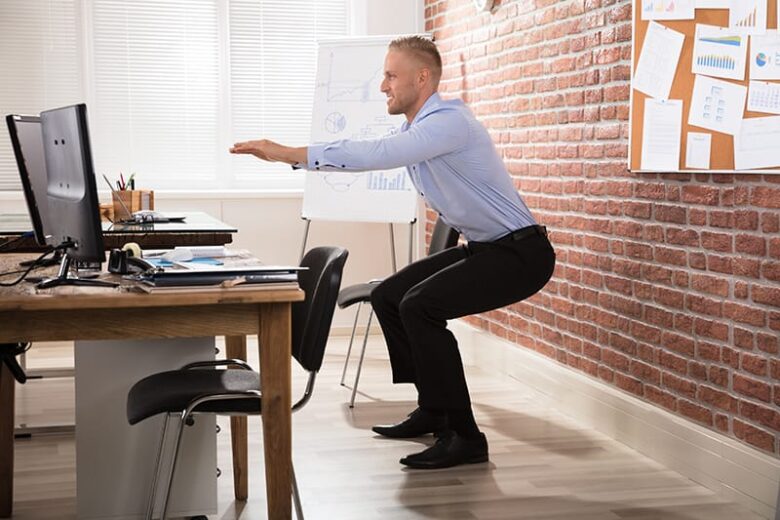Every office worker knows what it’s like to sit at a desk for long periods of time. It’s easy to forget about posture, movement, and the damage that sitting for hours can do to the body when you are busy with important things. Sitting for long periods of time can make you stiff, give you lower back pain, make your shoulders tight, and even make you less productive. You don’t have to get up from your job or work out for hours to feel better. Quick desk movements can be done in just a few minutes, right where you work, and they help improve circulation, ease stress, and boost energy levels.
This piece will talk about useful work exercises that you can easily add to your daily practice. These easy moves are made for busy office workers who want to stay healthy, alert, and creative without getting in the way of their work.
Why it’s important to do desk exercises
People who work in offices often have to sit down for long periods of time, which can lead to what experts call “sedentary behavior.” This lack of movement can hurt your balance, make your muscles stiff, and even raise your risk of getting long-term health problems. Quick movements at your desk are a useful answer that can help your mind and body recover from long periods of sitting.
By adding small bursts of movement throughout the day, you can reduce muscle pain and tightness, improve posture and balance, increase blood flow and energy, and lower stress and mental fatigue. The best part is that these exercises are simple, won’t draw attention to you, and don’t need any special tools.
Easy ways to stretch your shoulders and neck
Having tension in the shoulders and neck is something that a lot of office workers worry about. When you stare at screens for a long time, these muscles tend to get tight. If this hurts, try doing gentle neck rolls by sitting up straight, letting your chin hang a little, and rolling your head in a circle. It helps to loosen up to do this slowly for twenty seconds in each direction.
Another great choice is the shoulder shrug. Just bring your shoulders up to your ears, hold for a second, and then let go. When you do this several times, your shoulders start to feel lighter. You can also stretch your upper back by putting your fingers together, stretching your arms forward, and slowly pulling your hands away from your body. This makes the muscles in your upper back feel better and makes you more flexible.
Back exercises that you can do at your desk
Back pain is another problem that a lot of office workers have. Regular stretches that support your spine can help ease pain and make your balance better. A simple spine twist while sitting down is very helpful. Put your right hand on the back of your chair and sit up straight. Then, slowly twist your body to the right. Once you’ve done that, do it again on the other side.
The cat-cow stretch is another good practice. Breathe in, raise your back, and push your chest forward. Then put your hands on your legs. Round your back and tuck your chin as you let out your breath. This should be done eight to ten times to keep your back open. Place your feet flat on the ground, bend forward from your hips, and let your arms hang down to the floor. This is called a sitting forward bend. This helps ease back pain in the lower back.
Quick moves for your legs and hips
When you sit for hours, your legs’ blood flow slows down and your hip muscles get tight. Gentle stretches can help get blood flowing again and loosen up stiff muscles. To do seated leg extensions, just sit down and straighten out one leg. Hold for a few seconds, then bring it back down. Moving your legs back and forth helps keep your lower body busy.
Another good move is the hip opening stretch. Make a figure-four shape by crossing your right ankle over your left knee. Then, lean forward a little to stretch your hips. Keep it in place for twenty seconds, then switch sides. Lift one foot off the ground and rotate your ankle clockwise and counterclockwise. This will keep your ankles loose and improve blood flow.
Works out your hands and wrists
It can be hard on your arms and hands to type and use a mouse for long periods of time. Stretching at your desk can help keep you from getting stiff and may even lower your risk of getting repetitive strain injuries. To do a simple wrist stretch, put one arm out in front of you with the palm facing up and slowly pull back on your fingers with the other hand until you feel a stretch. The wrists stay flexible when you hold for fifteen seconds on each side before switching sides.
Hand stress can be eased by spreading your fingers as far apart as you can, keeping them for a few seconds, and then letting go several times. By moving your wrists slowly in both directions for ten seconds at a time, you can also improve your circulation and range of motion.
Desk aerobics can give you more energy
Getting a boost of energy can be just what you need after a long day at work. Quick exercise at your desk is a great way to wake up your mind and get your blood moving. One easy way to do this is to march while sitting down. For thirty seconds, lift your knees back and forth as if you were moving while you are sitting.
Another great choice is chair squats. Before you sit down, stand in front of your chair and bend over. Then, lift yourself back up. Ten to twelve times of this makes your legs stronger and improves blood flow. For calf raises, you can also stand behind your chair, hold the backrest for balance, and lift your heels off the ground. Your leg muscles get stronger and more blood flows to them when you hold for a few seconds before lowering.
How to Make Working Out at Your Desk a Habit
Getting started is often the hardest part, but doing these exercises regularly is what makes them really work. You might want to stretch or move around every hour or two if you set a reminder. Another important thing is to keep workouts short. Moving for just two to five minutes can make a difference.
For extra encouragement, work out with people you work with, or do routines while doing daily jobs, like stretching while talking on the phone. These small steps will help you make desk movements a normal part of your job over time, rather than something you feel like you have to do.
Questions People Ask Often
How often should I work out at my desk?
Every hour to two hours, you should do some short movements. An easy two- or three-minute stretch can help you relax and concentrate better.
Do I need any special tools to do desk exercises?
Yes, you can do all of those movements with just your desk and chair. Resistance bands and other extras can make your workout better, but they are not required.
Can workouts done at a desk really help you get more done?
Yes, daily exercise does improve blood flow, make you feel less tired, and clear your mind, all of which can help you focus and get more done.
What if it makes me feel bad to work out in front of my coworkers?
You can do most work movements without drawing too much attention to yourself. You can also begin with shorter stretches until you feel better.
Do desk movements take the place of regular workouts?
Desk movements should not be used instead of a full workout plan, but they can be used to add to one. They keep you moving all day and lessen the bad effects of sitting for long periods of time.
In conclusion
Short workouts you can do at your desk are an easy and effective way to deal with the stress of long work hours. Just by stretching your neck, shoulders, back, hips, and arms for a few minutes a day, you can make your balance much better, feel less stiff, and have more energy. These small moves are good for your health and can also help you concentrate and get more done at work.
Remember that a few quick stretches can help the next time you feel stressed at your work. You don’t have to go to the gym to stay busy. You can start right where you are.




